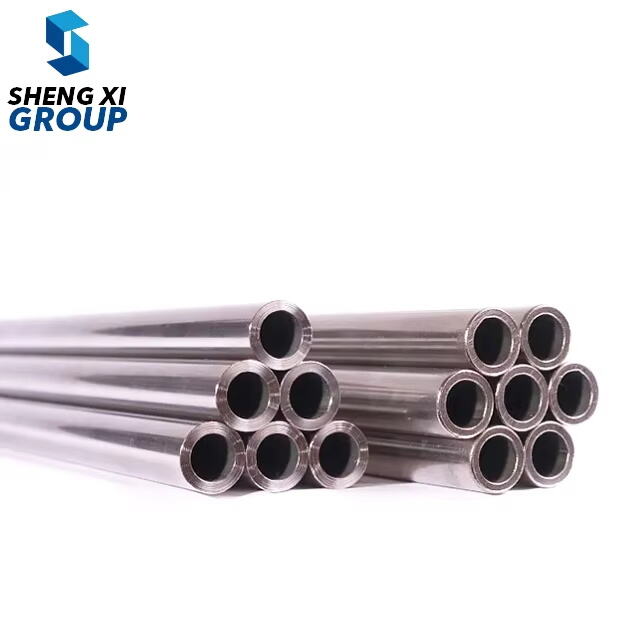Wichtige Festigkeitswerte von Legierungsstahl
Zugfestigkeit: Messung der maximalen Lastkapazität
Die Zugfestigkeit zeigt, wie gut ein legierter Stahl einer Dehnung oder einem Zugbelastung standhält, also im Grunde, ob er unter Druck reißt. Die meisten legierten Stähle weisen durchschnittlich Zugfestigkeiten von über 600 MPa auf, was sie für die verschiedensten beanspruchenden Anwendungen äußerst robust macht. Dieses Merkmal ist besonders in Bereichen wie dem Bau großer Konstruktionen oder der Flugzeugherstellung von großer Bedeutung, da die dort verwendeten Teile auch bei massiven Zugkräften stabil bleiben müssen. Stellen Sie sich vor: Hängebrücken, die ganze Städte tragen, oder Flügel von Flugzeugen, die während des Fluges extremen Belastungen standhalten müssen. Die Prüfung der Zugfestigkeit folgt Leitlinien, wie sie beispielsweise in den Normen ASTM E8 festgelegt sind. Solche Tests stellen sicher, dass die Materialien tatsächlich den maximalen Lasten standhalten können, für die sie vorgesehen sind, ohne unerwartet zu versagen.
Festigkeitsgrenze: Verständnis der elastischen Grenzen
Die Streckgrenze von Materialien zeigt an, wann sie beginnen, dauerhaft zu verformen, anstatt nach einer Belastung in ihre ursprüngliche Form zurückzukehren. Legierter Stahl hat in der Regel Streckgrenzen von etwa 250 MPa oder höher, was ihn ziemlich zuverlässig macht, um sichere Konstruktionen zu bauen. Wenn Ingenieure Gebäude oder Brücken planen, betrachten sie diese Werte, um herauszufinden, wie viel Gewicht etwas tragen kann, bevor es anfängt sich zu biegen oder zu brechen. Fachleute aus der Industrie wissen, wie wichtig das in Bereichen wie Offshore-Bohrplattformen oder industriellen Chemieanlagen ist. Ein einzelner Ausfall dort könnte massive Probleme für Arbeiter und Ausrüstung verursachen. Deshalb achten viele Bauteams bereits in der Planungsphase besonders genau auf diese Werte. Schließlich will niemand Überraschungen erleben, wenn es um schwere Lasten und kostspielige Infrastrukturprojekte geht.
Güte: Widerstand gegen plötzliche Kräfte
Die Schlagzähigkeit von Legierungsstahl sagt uns im Grunde, wie gut er plötzlichen Stößen und Schlägen standhalten kann, was ihn besonders wichtig für Dinge macht, die in rauen Umgebungen langlebig sein müssen. Wenn Ingenieure Tests wie den Charpy- oder Izod-Schlagbiegeversuch durchführen, erhalten sie Durchschnittswerte, die zeigen, wie viel Kraft der Stahl aushält, bevor er bricht. Es gibt zahlreiche Beispiele aus der Praxis, bei denen Materialien versagt haben, weil ihnen die nötige Schlagzähigkeit fehlte, was zu schweren Unfällen und kostspieligen Reparaturen führte. Deshalb sind die technischen Spezifikationen beim Bau von Konstruktionen und Maschinen von großer Bedeutung. Normorganisationen haben Richtlinien wie ASTM E23 speziell für diese Tests entwickelt, damit Hersteller genau wissen, welche Anforderungen ihre Materialien erfüllen müssen. Die Einhaltung dieser Standards hilft dabei, sicherzustellen, dass verschiedene Arten von Legierungsstählen unter Belastung tatsächlich funktionieren und nicht unerwartet versagen.
Härte und Zähigkeit im Legierungsstahl
Verschleißwiderstand durch Oberflächenhärte
Die Härte der Oberfläche eines Materials spielt bei Legierungsstählen eine große Rolle, da sie dabei hilft, Verschleiß und Abnutzung zu widerstehen, was besonders wichtig wird, wenn Teile in schweren Anwendungen ständig aneinander reiben. Die meisten Menschen messen die Oberflächenhärte auf der sogenannten Rockwell-Skala, und hochwertiger Legierungsstahl erreicht dort in der Regel Werte über 60. Werkzeughersteller und Produzenten, die große Maschinen betreiben, verlassen sich stark auf diese Eigenschaft, da ihre Betriebe bei schneller Abnutzung der Komponenten hohe Kosten entstehen können. Forschungen zeigen eindeutig, dass ein Zusammenhang zwischen härteren Oberflächen und längerer Lebensdauer der Teile besteht, was bedeutet, dass im Laufe der Zeit weniger Ersatzteile benötigt werden. Dies macht in Fabriken, in denen Maschinen ununterbrochen laufen, tatsächlich einen spürbaren Unterschied aus, da dadurch sowohl Reparaturkosten als auch Stillzeiten reduziert werden und sich zudem die Dauer verlängert, in der Anlagen produktiv bleiben, bevor sie ersetzt werden müssen.
Zähigkeit: Den Gleichgewicht zwischen Stärke und Bruchwiderstand halten
Die Zähigkeit von Legierungsstahl spielt eine große Rolle, denn sie zeigt, wie gut das Metall standhält, wenn es gedehnt wird (Duktilität), im Vergleich dazu, wenn es stark beansprucht wird (Festigkeit). Für Anwendungen wie Öl-Pipelines oder Druckbehälter wird diese Balance besonders wichtig, da das Material in der Lage sein muss, hohen Druck zu widerstehen und gleichzeitig Schäden durch plötzliche Schläge entgegenzuwirken. Ingenieure führen Tests wie den Charpy-Schlagbiegeversuch durch, um festzustellen, wie Metalle reagieren, wenn sie stark belastet werden. Dies hilft dabei zu bestimmen, ob sie unter schwierigen Bedingungen ordnungsgemäß funktionieren werden. Metall-Experten haben eine interessante Beobachtung gemacht: Die Zusammensetzung der Legierung beeinflusst tatsächlich die Zähigkeit des Endprodukts. Manche Legierungen eignen sich hervorragend für Unterwasser-Konstruktionen, aber bei tiefen Temperaturen könnten sie Probleme aufweisen, während andere wiederum in Hochtemperatur-Umgebungen besonders gut abschneiden. Durch gezielte Anpassung dieser Zusammensetzungen entwickeln Hersteller Materialien, die exakt den Anforderungen des jeweiligen Einsatzgebiets entsprechen.
Die Rolle des Kohlenstoffgehalts bei der Härte
Die Menge des vorhandenen Kohlenstoffs beeinflusst tatsächlich, wie hart und welche Art von mechanischen Eigenschaften die Legierungsstähle aufweisen. Mehr Kohlenstoff bedeutet in der Regel härteren Stahl, wodurch diese Materialien zu idealen Wahlmöglichkeiten bei der Herstellung von Werkzeugen oder Maschinenbauteilen werden, die harten Bedingungen standhalten müssen. Nehmen Sie beispielsweise Schneidwerkzeuge – solche, die mit genau dem richtigen Kohlenstoffgehalt hergestellt werden, funktionieren deutlich besser und halten länger. Etwas, auf das Hersteller nicht verzichten können, da ihre Maschinen darauf angewiesen sind. Studien zeigen, dass der Kohlenstoffgehalt auch eine Rolle bei der Wärmebehandlung spielt. Wenn Metallbauer diese Erhitzungs- und Abkühlzyklen richtig anpassen, erzielen sie bessere Härteergebnisse bei ihren Legierungsstählen. Das ist von Bedeutung, denn stärkere und verschleißfestere Materialien bedeuten weniger Ausfälle in verschiedensten Fertigungsbereichen.
Elastizität und Zugfestigkeit: Flexibilität unter Belastung
Elastizitätsmodul in Anwendungen von Legierungsstahl
Der Elastizitätsmodul spielt bei der Arbeit mit legierten Stählen eine sehr wichtige Rolle und liegt üblicherweise irgendwo zwischen 200 und 210 Gigapascal. Grundsätzlich gibt er an, wie viel ein Material gebogen oder gedehnt werden kann, bevor es bricht, und wie gut es danach wieder in seine ursprüngliche Form zurückkehrt, sobald die einwirkende Kraft entfernt wird. Ingenieure verlassen sich bei der Konstruktion verschiedenster Strukturen stark auf diese Eigenschaft, denn niemand möchte, dass eine Brücke oder ein Gebäude unerwartet durchhängt oder sich verformt. Das richtige Gleichgewicht zwischen ausreichender Flexibilität, um Belastungen standzuhalten, und gleichzeitiger Steifigkeit, um die Form zu bewahren, ist entscheidend für den langfristigen Erfolg von Bauprojekten. Studien verschiedener Forschungsgruppen zeigen, dass eine präzise Abstimmung der elastischen Eigenschaften strukturelle Ausfälle deutlich reduziert. Deshalb ist die Wahl des richtigen Legierungsstahls für Bauwerke, die Jahrzehnte statt nur Jahre halten sollen, von so großer Bedeutung.
Dehnungsmessungen für die Umformbarkeit
Duktilität sagt uns im Grunde, wie viel ein legierter Stahl gedehnt oder verdreht werden kann, bevor er bricht. Dies messen wir anhand von Dehnungsprozenten und der Querschnittsverringerung während Zugversuchen. Wenn Werkstoffe eine gute Duktilität aufweisen, vereinfacht dies das Arbeiten in Fertigungsbetrieben erheblich. Stellen Sie sich Fertigungsverfahren oder Schweißarbeiten vor, bei denen Metall geformt und umgeformt werden muss, ohne zu brechen. Ohne ausreichende Flexibilität würden solche Prozesse nicht richtig funktionieren. Bei der Fertigung komplexer Bauteile und beim Aufbau von Konstruktionen spielt diese Verformbarkeit eine große Rolle, da sie dafür sorgt, dass die Produktion reibungslos abläuft, statt plötzlich zum Erliegen zu kommen. Die meisten Industriezweige haben feste Standards für das Maß an Duktilität, das verschiedene Legierungen aufweisen sollten. Diese Richtwerte helfen Ingenieuren dabei, das richtige Material für ihre Projekte auszuwählen – ob bei der Herstellung von Fahrzeugrahmen oder Flugzeugteilen, also überall dort, wo Werkstoffe unter Belastung stehen und sich bei Bedarf verformen müssen.
Spannung-Dehnungs-Beziehungen erklärt
Es ist wichtig zu wissen, wie sich Spannung zum Dehnung verhält, wenn man betrachtet, wie sich legierter Stahl unter Krafteinwirkung verhält. Spannungs-Dehnungs-Kurven dienen als grundlegende Werkzeuge, die zeigen, wann Materialien anfangen zu plastischen Verformungen überzugehen und letztendlich versagen, wodurch Ingenieure ein klares Bild der Leistungsfähigkeit unter verschiedenen Bedingungen erhalten. Solche Analysen helfen dabei, die Haltbarkeit von Materialien vorherzusagen und wie sie in Anwendungen von Bauunterstützungen bis hin zu Komponenten innerhalb großer Maschinen standhalten. Wenn Ingenieure diese Zusammenhänge genau untersuchen, können sie geeignete Materialien auswählen, die Abnutzung standhalten und gleichzeitig Sicherheit gewährleisten. Die Betrachtung von Diagrammen macht es einfacher, Konzepte wie die elastische Grenze und das Verhalten während der plastischen Verformung zu verstehen, was bei der Auswahl der richtigen Materialien für spezifische Aufgaben von großer Bedeutung ist.
Faktoren, die die mechanischen Eigenschaften von Legierungsstahl beeinflussen
Legierungsbestandteile: Auswirkungen von Chrom, Nickel und Molybdän
Legierter Stahl erhält seine besonderen Eigenschaften durch das Hinzufügen von Bestandteilen wie Chrom, Nickel und Molybdän zur Mischung. Diese Zugaben machen den Stahl fester, verbessern seinen Korrosionsschutz und steigern die Gesamtzähigkeit. Chrom beispielsweise erhöht deutlich die Widerstandsfähigkeit gegen Rost. Nickel sorgt dafür, dass der Stahl biegsam ist, ohne zu brechen, was für Teile vorteilhaft ist, die sich verformen müssen. Und dann gibt es noch Molybdän, das dafür sorgt, dass der Stahl auch bei hohen Temperaturen zäh bleibt. Wenn Hersteller die richtige Kombination dieser Elemente wählen, erzielen sie ziemlich beeindruckende Ergebnisse, die den geltenden Standards entsprechen. Die meisten Betriebe kennen dies aus eigener Erfahrung und nicht nur aus dem Lesen entsprechender Fachpapiere. Was den legierten Stahl in so vielen Bereichen so nützlich macht, ist nicht nur seine Festigkeit, sondern vielmehr der optimale Punkt, an dem all diese Eigenschaften harmonisch zusammenwirken.
Wärmebehandlungsprozesse und deren Auswirkungen
Wärmebehandlung ist äußerst wichtig, um die besten mechanischen Eigenschaften aus Vergütungsstahl zu gewinnen. Wenn wir von Verfahren wie Glühen, Härten und Anlassen sprechen, verändern wir tatsächlich die innere Struktur des Metalls auf mikroskopischer Ebene. Dies beeinflusst Eigenschaften, die für die Anwendung relevant sind – Härte, Festigkeit und wie weit das Material gedehnt werden kann, bevor es bricht. Nehmen wir beispielsweise das Härten gefolgt von Anlassen. Dieser Prozess bedeutet im Grunde, den Stahl so weit aufzuheizen, bis er rotglühend ist, und ihn anschließend rasch in Öl oder Wasser abzukühlen. Das Ergebnis? Stahl, der sowohl stabil als auch zäh genug für harte Einsätze ist. Aus praktischen Erfahrungen in echten Produktionsumgebungen zeigt sich, dass kleine Veränderungen in der Dauer oder Temperatur der Erwärmung einen großen Einfluss auf die Qualität des Endprodukts haben. Ingenieure, die an realen Projekten arbeiten, müssen sich mit diesen Verfahren beschäftigen, da unterschiedliche Anwendungen verschiedene Ergebnisse erfordern. Ein Bauteil für eine Brücke benötigt schließlich völlig andere Eigenschaften als ein Teil, das innerhalb eines Motorenblocks verwendet wird.
Fertigungsverfahren: Schmieden im Vergleich zum Gießen
Wie legierter Stahl hergestellt wird, ob durch Schmieden oder Gießen, hat einen großen Einfluss darauf, welche Art von Mikrostruktur sich in ihm bildet und wie stark er letztendlich wird. Schmieden ist in der Regel die bevorzugte Methode beim Herstellen von Bauteilen, die über eine erhebliche Festigkeit und Widerstandsfähigkeit gegen Brüche unter Belastung verfügen müssen, da dieser Prozess die interne Kornstruktur des Metalls tatsächlich zusammenpresst und neu ordnet. Gießen bietet jedoch etwas Anderes: Es erlaubt den Herstellern, äußerst komplexe Formen zu produzieren, die mit anderen Techniken schwierig oder unmöglich herzustellen wären. Allerdings gibt es hier auch einen Nachteil, da Gussstücke in der Regel weniger gleichmäßige innere Strukturen aufweisen, was bedeuten kann, dass sie nicht so belastbar oder flexibel sind wie vergleichbare geschmiedete Teile. Die Betrachtung von Testergebnissen verschiedenster Labore über die Jahre zeigt ziemlich deutlich, dass geschmiedeter legierter Stahl aufgrund der während des Schmiedevorgangs verbesserten Kornstrukturen in der Regel eine bessere mechanische Leistung erbringt. Die meisten Ingenieure, mit denen wir sprechen, empfehlen Schmieden, sobald die strukturelle Integrität besonders wichtig ist, insbesondere bei Komponenten für die Luftfahrt oder schwere Maschinen. Dennoch kann niemand die Vorteile leugnen, die das Gießen mitbringt, wenn es um komplexe Designs geht, die viel Detailarbeit erfordern.
Häufig gestellte Fragen
In welchen Branchen wird Legierungsstahl häufig verwendet?
Legierter Stahl wird aufgrund seiner verbesserten strukturellen Integrität und Leistungsfähigkeit weitgehend in der Baubranche, im Automobil- und Luftfahrtsektor eingesetzt.
Warum wird Legierungsstahl gegenüber Kohlenstoffstahl bevorzugt?
Legierungsstahl wird wegen seiner überlegenen Festigkeit, Zähigkeit und Korrosionsbeständigkeit bevorzugt und übertreffen Kohlenstoffstahl in verschiedenen Tests um bis zu 30%.
Wie beeinflusst die Zugfestigkeit die Anwendungen von Legierungsstahl?
Zugfestigkeit ist entscheidend in Branchen wie dem Bauwesen und der Luftfahrt, wo Materialien erhebliche Zugkräfte ohne Versagen aushalten müssen.
Welche sind die wichtigsten Legierungselemente im Legierungsstahl?
Chrom, Nickel und Molybdän sind Schlüsselmaterialien, die die Festigkeit, Korrosionsbeständigkeit und Zähigkeit des Legierungsstahls verbessern.
Welchen Einfluss hat die Wärmebehandlung auf Legierungsstahl?
Wärmebehandlungsverfahren wie Annealien, Erhitzen und Rückschlagen optimieren die mechanischen Eigenschaften von Legierungsstahl, indem sie seine Härte, Festigkeit und Zugfestigkeit anpassen.
Inhaltsverzeichnis
- Wichtige Festigkeitswerte von Legierungsstahl
- Härte und Zähigkeit im Legierungsstahl
- Elastizität und Zugfestigkeit: Flexibilität unter Belastung
- Faktoren, die die mechanischen Eigenschaften von Legierungsstahl beeinflussen
-
Häufig gestellte Fragen
- In welchen Branchen wird Legierungsstahl häufig verwendet?
- Warum wird Legierungsstahl gegenüber Kohlenstoffstahl bevorzugt?
- Wie beeinflusst die Zugfestigkeit die Anwendungen von Legierungsstahl?
- Welche sind die wichtigsten Legierungselemente im Legierungsstahl?
- Welchen Einfluss hat die Wärmebehandlung auf Legierungsstahl?


